In the fast-moving landscape of social media, crises can emerge unexpectedly, often in a matter of seconds. Whether triggered by a controversial tweet, a public relations blunder, or a product failure, a brand’s response during a crisis can significantly impact its reputation. The way a brand handles negative publicity can either lead to a swift downfall or become a defining moment that strengthens its relationship with customers.
While many brands falter under the weight of a crisis, there are others that, through strategic thinking and effective communication, have turned adversity into valuable opportunities for growth. These brands not only survive difficult situations but use them to build deeper customer loyalty, enhance brand transparency, and foster positive public perception. In fact, with the right crisis management approach, brands can transform potential setbacks into a platform for increased awareness, renewed trust, and even a stronger market position.
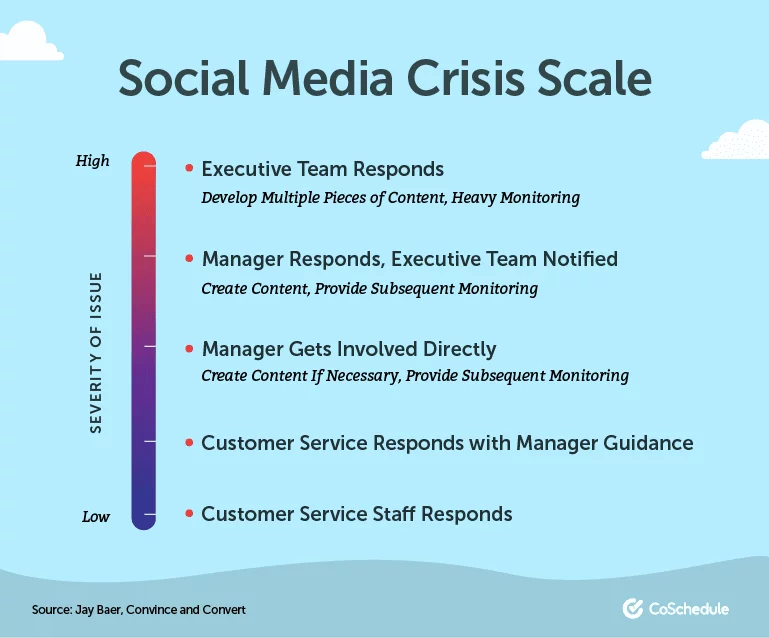
Let’s dissect some examples of social media crises that could have been averted and glean valuable insights from them.
The internet never forgets. Even with a robust crisis management strategy, unexpected blunders can still occur. In such moments, there’s only one recourse—learn to address them swiftly, in the heat of the moment.
What Constitutes a Social Media Crisis?
The answer might seem obvious, but it’s a valid question. When does a misstep escalate into a crisis?
In essence, a social media crisis encompasses anything that could tarnish your business’s reputation or standing via social platforms. A surge in negative sentiment during a crisis A surge in negative sentiment during the crisis involving the renowned singer Lizzo
It’s more than just a single unfavorable comment under a post. A crisis entails a deluge of disparaging remarks that spiral beyond your control.
Types of Social Media Crises
1. Multi-Channel Crisis
A multi-channel crisis occurs when negative feedback or controversy spreads across multiple social media platforms at once. This type of crisis can be particularly perilous due to its rapid, widespread nature. Once an issue gains traction on one platform, it can quickly spill over to others like Facebook, Twitter, Instagram, and even review sites, creating a tidal wave of negative publicity. The interconnectedness of platforms means that a single incident can snowball into a viral event that’s hard to control.
The danger lies in how quickly the crisis can escalate and the difficulty of managing responses across various channels simultaneously. If not handled with urgency and consistency, the backlash can grow exponentially, potentially harming a brand’s reputation long-term.
2. Emerging Crisis
An emerging crisis starts as a small issue or isolated incident but has the potential to escalate rapidly if not addressed promptly. These crises often begin with something relatively minor—a negative tweet, a customer complaint, or a flawed product launch. If caught early and handled properly, they can be resolved before they grow into major scandals. However, failing to address the problem in its early stages allows it to gather momentum, turning what could have been a minor blip into a full-scale public relations disaster.
The critical element in managing an emerging crisis is timely intervention. Proactive communication and swift action are essential in preventing the issue from snowballing out of control. Once a crisis has gained significant attention, it’s far more challenging to mitigate the damage.
3. Industry Crisis
An industry crisis occurs when a problem or scandal impacts an entire sector or industry, often due to unethical practices, regulatory failures, or a scandal involving a prominent vendor, partner, or competitor. While the initial issue may be confined to one company, the consequences quickly ripple across the industry, affecting others as consumers begin to question the practices of the sector as a whole. Brands in the same industry may suffer collateral damage, as the public perception of the entire field becomes tainted.
These types of crises are particularly difficult for individual brands to navigate because the problem is not theirs alone to resolve. They must not only manage their own reputation but also contend with the wider industry fallout, which can be complex and widespread.
4. Fake News
In today’s digital age, misinformation can spread like wildfire, often causing a significant crisis for brands. Fake news refers to false or misleading information that circulates online, often through social media platforms, blogs, or websites. This type of crisis can be especially damaging because it’s difficult to control the spread of rumors, and the truth may not reach the audience in time. Once misinformation gains traction, it can significantly impact a brand’s reputation and consumer trust.
The challenge for brands is not just identifying fake news but also responding quickly and effectively to debunk it before it goes viral. Addressing false claims with clear, accurate information is essential to mitigate the damage, but the longer the misinformation remains unchecked, the harder it becomes to repair the brand’s image.
Avoiding the Fallout: Real-Life Examples of Brands That Got It Right
1. KFC
In 2018, KFC UK & Ireland faced an unexpected crisis when a delivery failure caused a chicken shortage, affecting most of their 870 locations. This was a major disruption for the brand, but they quickly turned the situation around by embracing transparency and humor.
Instead of ignoring the issue, KFC’s PR and marketing teams responded with creativity and wit, launching an iconic campaign where the KFC logo was rearranged to spell “FCK,” humorously acknowledging the mishap. They also used their website and social media to keep customers updated on the status of chicken availability, showing a commitment to open communication.
This transparency, combined with a bold and playful approach, diffused potential backlash and even increased customer loyalty. By staying true to its brand voice and addressing the situation head-on, KFC turned a negative experience into a positive one.
Key Features:
- Transparency: KFC openly acknowledged the problem and provided regular updates, building trust with customers.
- Creative Response: Using humor and creativity, KFC humanized the crisis and made the situation more relatable.
- Timely Communication: Constant updates kept customers informed and minimized frustration.
- Brand Consistency: KFC maintained its distinctive voice and identity, which resonated well with its audience.
- Customer-Centric Approach: KFC prioritized customer satisfaction by providing information and showing humility.
2. Southwest Airlines
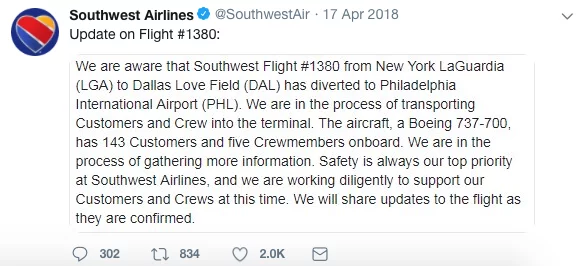
On April 17, 2018, Southwest Airlines experienced a deeply tragic event when one of its flights, Flight 1380, suffered an engine explosion, leading to the loss of life. The airline was faced with an immense crisis that demanded quick and thoughtful crisis management.
In response, Southwest’s CEO Gary Kelly and his team moved swiftly to reach out to affected passengers and their families, offering financial assistance, travel arrangements, and trauma counseling. The airline’s social media team focused on human-centered communication, avoiding automated responses in favor of personal engagement.
Southwest also carefully monitored online discussions, using real-time insights to adjust their messaging as necessary. By maintaining empathy and offering personalized support, the airline not only handled the immediate crisis effectively but also reinforced its reputation as a compassionate company.
Key Features:
- Personalized Assistance: Southwest focused on providing individual support, demonstrating care for the well-being of its passengers.
- Swift Response: The airline’s leadership acted quickly to offer support and financial aid to those affected.
- Human Touch: Personalized responses instead of automated replies helped build deeper emotional connections.
- Transparency: Southwest kept affected individuals informed and managed public conversations carefully.
- Crisis Monitoring: Monitoring public sentiment allowed the airline to respond with tailored messages.
Learn about SMM panels here.
3. Slack
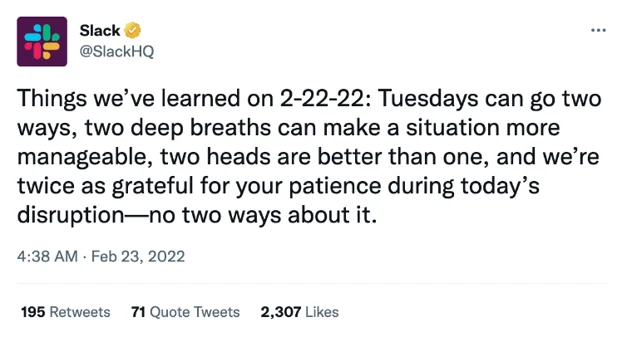
In February 2022, Slack experienced a major outage that disrupted service for many of its users. While service interruptions can be a common frustration, Slack handled the situation with remarkable transparency and timeliness, which helped retain trust among its user base.
Upon identifying the issue, Slack immediately began posting regular updates on their status page, offering real-time information on the progress of resolving the outage. In addition, they issued a sincere apology on Twitter, showing empathy toward users who were impacted by the disruption.
Slack’s commitment to keeping users informed, coupled with their transparent communication style, earned praise from users for their honesty and proactive approach, even in the face of an outage that affected productivity.
Key Features:
- Regular Updates: Slack provided continuous updates, ensuring that users were always informed of the progress.
- Timely Communication: Updates were released promptly every half hour, keeping users engaged throughout the incident.
- Social Media Engagement: Slack used Twitter to personally apologize to users and show genuine concern for the inconvenience.
- User-Centric Approach: The brand focused on making the experience as smooth as possible for their users during a difficult time.
- Positive Reception: Slack’s openness and honesty led to positive feedback, reinforcing their users’ trust in the platform.
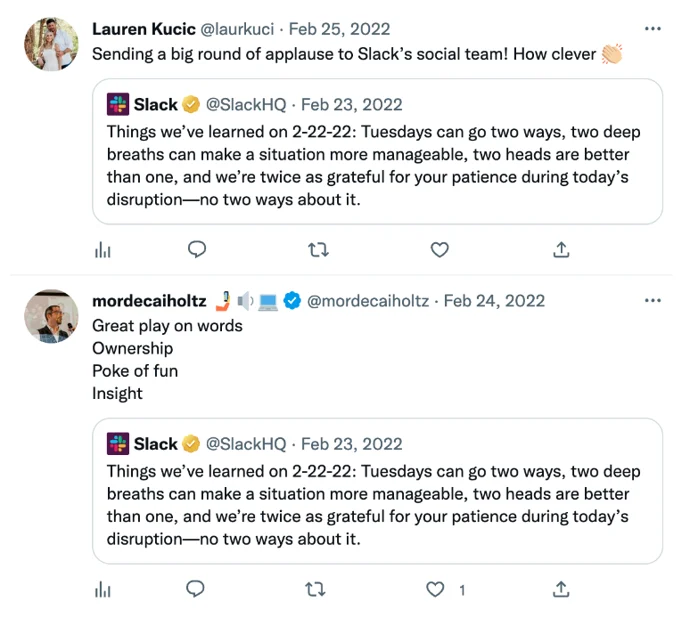
4. Starbucks
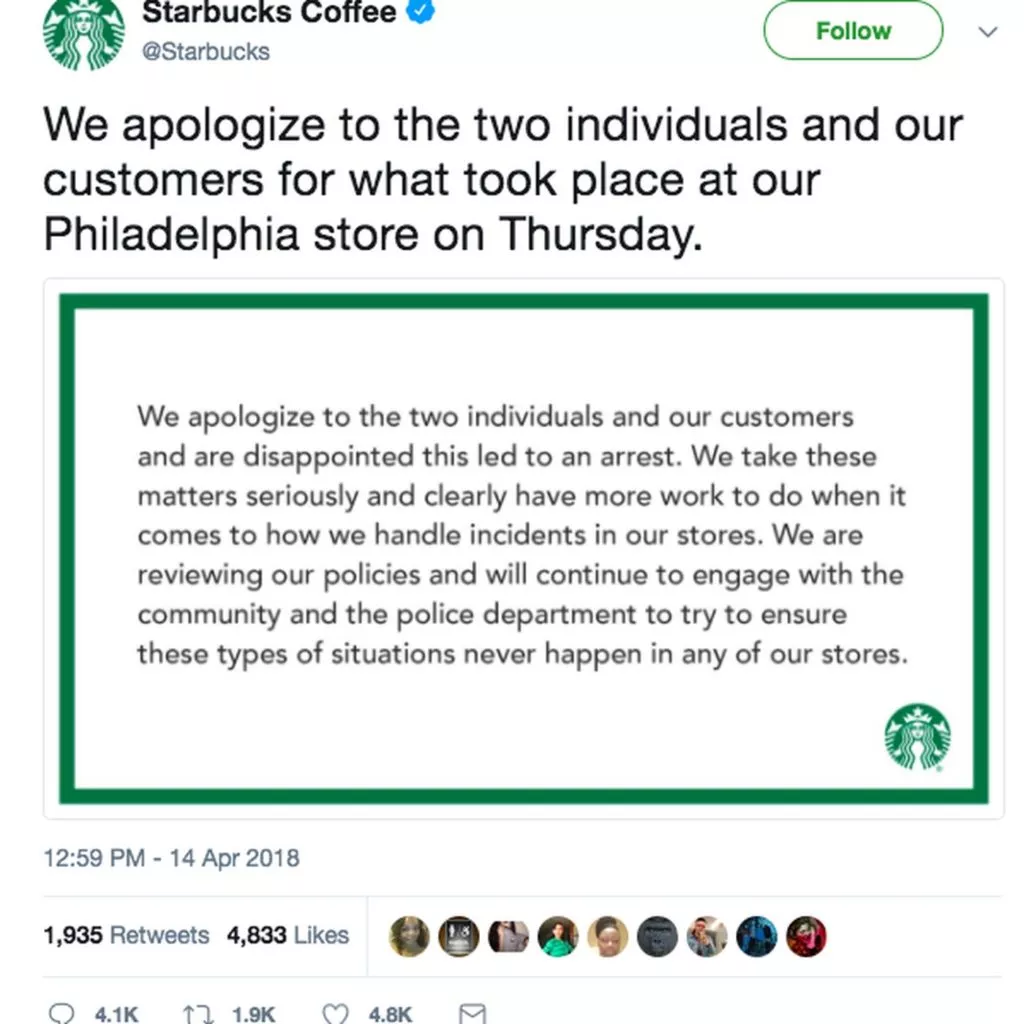
In April 2018, Starbucks faced a massive public backlash after two black men were wrongfully arrested at a Starbucks store in Philadelphia. The incident sparked outrage and became a national conversation about racial bias in the service industry.
Starbucks CEO Kevin Johnson responded quickly with a public apology and made it clear that the company would take action to prevent such an incident from happening again. The brand implemented a nationwide initiative to address racial bias, including closing all 8,000 U.S.-based stores for one afternoon to provide racial bias training to employees.
Starbucks’ immediate responsibility, proactive measures, and commitment to correcting systemic issues helped shift the conversation from a negative incident to a demonstration of corporate responsibility. Their handling of the situation reinforced the company’s commitment to diversity and inclusion, ultimately rebuilding trust with customers.
Key Features:
- Swift Apology: CEO Kevin Johnson’s prompt and public apology helped defuse tension.
- Decisive Action: The company took responsibility and implemented corrective measures, including firing the store manager involved.
- Nationwide Initiative: Starbucks closed stores for training, highlighting their commitment to resolving racial bias.
- Proactive Approach: By addressing the issue head-on, Starbucks managed to control the narrative and focus on positive change.
- Positive Reception: The company received praise for its proactive steps and efforts to promote inclusivity.
5. Tide
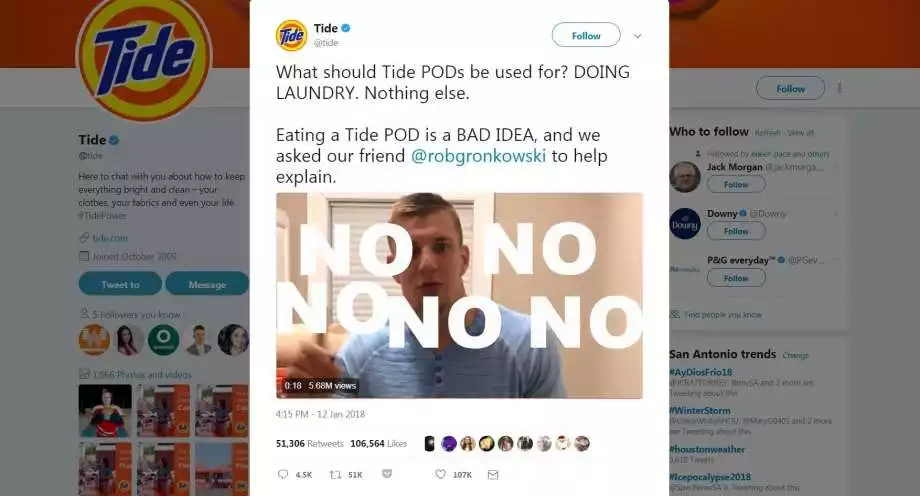
In 2018, Tide found itself in the middle of a dangerous social media trend—the “Tide Pod challenge,” where teenagers filmed themselves eating laundry pods for internet fame. As the challenge gained popularity, it led to serious health concerns and hospitalizations.
To address the crisis, Tide launched a targeted social media campaign, featuring NFL star Rob Gronkowski, aimed at discouraging participation in the dangerous trend. Gronkowski used his influence to deliver a strong, memorable message that the Tide Pod challenge was not only unsafe but also foolish. The campaign focused on educating teenagers about the risks of consuming laundry pods and conveyed that safety should come before viral fame.
By using celebrity influence and emphasizing responsibility, Tide successfully shifted the conversation and discouraged participation in the harmful trend.
Key Features:
- Proactive Response: Tide acted quickly to address the alarming trend and protect public health.
- Celebrity Endorsement: The use of a high-profile figure like Rob Gronkowski amplified the message and reached a broader audience.
- Message Reinforcement: The campaign emphasized safety and the dangers of participating in the challenge.
- Educational Focus: Tide’s initiative focused on raising awareness and promoting responsibility.
- Brand Responsibility: Tide’s commitment to safety and social responsibility strengthened its image as a brand that cares about its customers.
Crisis Averted: How to Manage a Social Media Crisis Like a Pro
1. Act Quickly and Be Proactive
Why it’s important: The longer a crisis goes unaddressed, the more likely it is to escalate. Social media spreads information (both good and bad) quickly, and delays in responding can worsen the situation.
Best Practice:
- As soon as a crisis emerges, acknowledge it publicly and let your audience know that you are working on a resolution. Immediate action shows that you’re taking the situation seriously and are committed to addressing it.
- Stay ahead of the conversation by proactively sharing updates, even if the situation is still developing.
2. Be Transparent and Honest
Why it’s important: Transparency builds trust. Trying to cover up or downplay a crisis can make matters worse and alienate your audience.
Best Practice:
- Acknowledge the issue honestly, even if it reflects poorly on your brand. If there was an error or misstep, admit it openly.
- Regularly provide updates throughout the resolution process to show that you’re actively working to fix the problem.
- Avoid using generic or vague responses—be specific about what you’re doing to resolve the issue.
3. Maintain a Consistent and Calm Tone
Why it’s important: Emotions can run high during a crisis, and your audience may be upset. Your response should help defuse tension, not escalate it.
Best Practice:
- Stay calm and empathetic in your communication. Avoid being defensive, dismissive, or reactive, even if the criticism feels unfair.
- Use language that reflects your brand’s tone but remains respectful and understanding of the situation. Acknowledge how your customers feel, and show that you care about their concerns.
4. Take Responsibility and Apologize Sincerely
Why it’s important: A sincere apology can go a long way in repairing your brand’s reputation and showing that you value your customers’ feedback.
Best Practice:
- Acknowledge what went wrong and take responsibility without shifting blame to external factors or other parties. A half-hearted apology or deflection can damage your credibility.
- Apologize publicly and personally, either through social media posts, press releases, or direct messages to those affected. Your apology should feel genuine and not just a formality.
5. Provide a Clear Plan of Action
Why it’s important: Customers want to know what steps you are taking to resolve the issue and prevent it from happening again.
Best Practice:
- Explain the concrete steps you’re taking to address the crisis and prevent future occurrences. This could include policy changes, refunds, or offering compensation where necessary.
- Keep your audience informed as things progress. Regular updates on how you’re resolving the issue will show commitment to fixing the problem.
6. Monitor Social Media and Engage Actively
Why it’s important: Social media is a two-way conversation. Listening to what your audience is saying allows you to respond effectively and stay in tune with their concerns.
Best Practice:
- Use social listening tools to monitor mentions of your brand across all platforms. This helps you gauge public sentiment and understand the scope of the crisis.
- Engage with your audience by responding to comments and questions, but keep interactions focused on resolution and empathy. Show that you’re actively listening and acting on feedback.
7. Keep Internal Communication in Sync
Why it’s important: Consistent communication within your team ensures that your response remains unified and coherent across all channels.
Best Practice:
- Establish a crisis communication plan that includes key messaging and guidelines for how team members should respond to media inquiries, customer questions, and internal updates.
- Ensure all employees (especially those interacting with customers) are well-informed and on the same page, so the messaging remains consistent across the board.
8. Turn the Crisis Into an Opportunity for Improvement
Why it’s important: Crises are often opportunities in disguise. When handled well, they can show your brand’s commitment to growth, customer care, and transparency.
Best Practice:
- Once the crisis is resolved, reflect on what you’ve learned. Implement changes to prevent similar issues in the future.
- Communicate these improvements to your audience, showing that you’ve taken steps to enhance your brand’s operations or policies. This can strengthen customer loyalty and even attract new followers who appreciate your transparency and adaptability.
9. Avoid Escalating the Crisis
Why it’s important: Sometimes, responding poorly to a crisis can amplify the damage, especially when emotions are running high on social media.
Best Practice:
- Avoid getting defensive or combative with critics. Do not engage in public arguments or “fighting back” against detractors, as it can make your brand appear unprofessional or tone-deaf.
- If necessary, take conversations offline—offer to resolve issues in private through direct messages, emails, or customer support.
10. Use Humor Wisely (When Appropriate)
Why it’s important: Humor can help diffuse tension and humanize your brand, but it must be used carefully, especially during sensitive crises.
Best Practice:
- If your brand has a history of using humor and creativity in its marketing, and the crisis is light-hearted in nature, a clever, well-timed response can show that you’re self-aware and not taking the situation too seriously.
- However, humor should only be used when it aligns with your brand’s tone and when the crisis is not too severe or sensitive. Always prioritize respect and empathy over humor.
Building a Resilient Brand for the Unexpected
Social media plays a crucial role in modern communication, offering brands a platform to engage with customers and promote their products or services. However, this connectivity also exposes companies to the risk of social media crises, where negative events or controversies can quickly spiral out of control and damage a brand’s reputation. Successfully navigating these crises requires a well-thought-out approach that emphasizes transparency, empathy, and quick action.
When a social media crisis occurs, brands need to act swiftly to address the issue and reduce its impact on their reputation and customer trust. This often involves publicly acknowledging the problem, providing timely updates, and showing a clear commitment to resolving the issue. By being transparent and taking responsibility, companies can rebuild trust and credibility with their audience.
Ensure your website is prepared for any crisis, big or small, with Nestify Hosting. With reliable performance, excellent security features, and outstanding customer support, Nestify helps safeguard your online presence. Get started today and protect your brand’s reputation with a hosting solution you can count on.
FAQs on the Brand Survival Guide
How can companies leverage data analytics to inform their social media crisis management strategies?
- Analyzing data and metrics related to the crisis, such as engagement levels, sentiment analysis, and audience demographics, can provide useful insights into the effectiveness of the company’s response.
- Companies can use data to identify trends, patterns, and areas for improvement in crisis management strategies, providing them to refine and optimize their approach over time.
- Advanced analytics tools and technologies, such as social media listening platforms and predictive analytics, can help companies anticipate and mitigate potential crises before they escalate.
What role does employee training and preparedness play in effective social media crisis management?
- Providing comprehensive training and guidance to employees on crisis communication protocols, social media best practices, and brand messaging can empower them to respond effectively during a crisis.
- Conducting regular crisis simulation exercises and scenario planning workshops can help employees practice their response skills and ensure readiness to handle unexpected situations.
- Establishing clear roles, responsibilities, and escalation procedures within the organization can streamline communication and decision-making during a crisis, minimizing confusion and delays.
How can companies leverage positive storytelling and brand narratives to offset the impact of a social media crisis?
- Crafting compelling narratives that highlight the company’s values, mission, and positive impact can help shift the focus away from the crisis and towards the brand’s strengths and achievements.
- Leveraging user-generated content, testimonials, and success stories can reinforce positive brand associations and counteract negative sentiment.
- Engaging in purpose-driven marketing initiatives and community outreach efforts can demonstrate the company’s commitment to making a positive difference, helping to rebuild trust and credibility with stakeholders.



